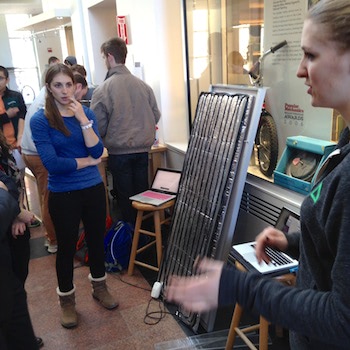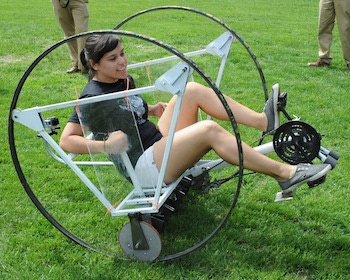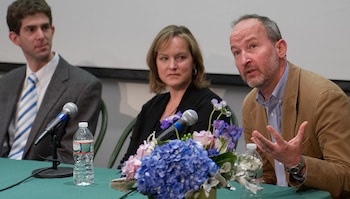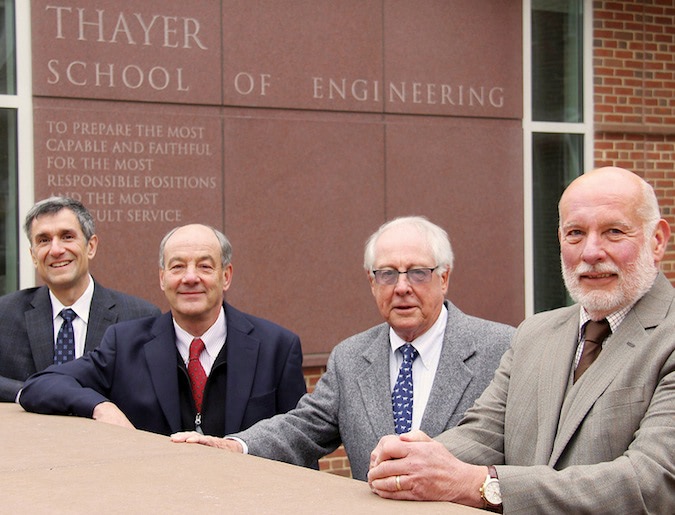- Undergraduate
Bachelor's Degrees
Bachelor of ArtsBachelor of EngineeringPartner School Dual-DegreeUndergraduate AdmissionsUndergraduate Experience
- Graduate
Doctoral Degrees
Doctor of PhilosophyPhD Innovation ProgramDoctor of Medicine-PhDGraduate AdmissionsGraduate Experience
- Research
- Entrepreneurship
- Community
- About
-
All Thayer News

Introduction to Engineering students present "WinterGreen," a remote-controlled solar panel snow removal system.

Students designed and built diwheel cars for a computer-aided mechanical engineering design course. (See diwheel video)

Panelists (l to r) Solomon Diamond, Vicki May, and Tillman Gerngross.
NAE Presents Nation's Top Prize for Engineering Education to Dartmouth
May 14, 2014
When engineering professors John Collier ’72 Th’77, Robert Graves, Joseph Helble, and Charles Hutchinson ’68 were presented with the nation’s top prize for engineering education, the May 2 ceremony broke new ground. The occasion was the first time the National Academy of Engineering (NAE) awarded its Bernard M. Gordon Prize for Innovation in Engineering and Technology Education at the institution being honored rather than in Washington, D.C.
Presenting medallions and certificates to the honorees at a public ceremony at Dartmouth's Thayer School of Engineering, Dan Mote, President of the NAE, called the Gordon Prize “the largest engineering education award in the world, not just the United States.” Bernard M. Gordon, his wife Sophia, and Gordon Prize committee member Nicholas Donofrio were among the NAE delegation.
The Gordon Prize recognized Collier for his three decades of leading Dartmouth’s signature project-based introductory engineering course, ENGS 21, Hutchinson and Graves for Dartmouth’s Master of Engineering Management program, and Dean Helble for Dartmouth’s first-in-the-nation Ph.D. Innovation Program. The professors’ innovations comprise key elements of Dartmouth’s Engineering Entrepreneurship Program.
As part of the ceremony, a panel discussion showcased educational innovation throughout the engineering curriculum. The panel was moderated by Dean Helble and featured four professors who described the creative approaches they bring to their engineering classes:
INNOVATION: Guided Apprenticeships
Panelist John Collier, Dartmouth’s Myron Tribus Professor in Innovation, called ENGS 21 a guided apprenticeship rather than experiential learning. “Experiential learning is like when you climb a tree and the branch breaks and you land on your head on the ground. You’ve learned something. That was experiential learning,” he said. “If it were guided, a parent might come out and sit with you and talk to you about what just went on: is that branch dead or alive, is the branch small or large in diameter, were you in a willow or an oak tree, and how far out on that branch were you and what kind of stress were you applying? That would be a guided apprenticeship.
“In ENGS 21 we encourage the students to choose open-ended projects that would interest them and some clients—some users—and then attack it. But you guide them the whole way. It’s a very labor-intensive business. I don’t do it single-handedly. I typically have a class of 60–80 and 15–18 TAs, one per group, to guide them. We have four instructors in the shop who are trained to take care of these students and guide them and we have electrical and computer folks. There’s a network of folks that make a net under the students to help and guide them.”

Introduction to Engineering students present "WinterGreen," a remote-controlled solar panel snow removal system.
Collier demonstrated the power of the guided apprenticeship with a recent ENGS 21 project: “This past winter the project area was improving the quality life in winter. One group met with members of the community (that’s one of the key characteristics: get them out of the classroom, get them into the community), folks had solar panels and were frustrated that they couldn’t get snow off them and were worried about falling off roofs and injuring themselves. So the students started brainstorming about brushes and warm water, coatings on the panels, or pieces they could cover the panels with when it snowed. They finally sat down and realized what they really needed to know was what the customers wanted. They went back out, talked to the customers, and asked them what their specifications were. It turned out the customers were very interested in aesthetics, what this thing was going to look like. They didn’t want to use power off the line. They wanted simple and straightforward. The students came up with a bunch of techniques they applied and they failed. They tried warm water and it didn’t work. They tried brushes and they didn’t work.
“One of the things I learned when I started teaching the course—and when I took the course—was that you have to fail. My mentor, Fred Hooven, used to say: ‘Fail early and often’ because you learn from every failure. You don’t learn if you don’t fail and you’re not learning if you’re not guided to understand those failures.
“The students eventually came up with a solution that was to heat the panels. They tried to heat them from the front and the down side of that was they had to use the panel itself as the heating element. The user said, does that work, and the students said, yes, but it may lower the life of the panel. They didn’t like that. They came up with a way of heating it from behind with an easy retrofit. People really liked it, but then the students had to do the immersion process of: does it work? So they go out and put snow on the panel and set it up and sit there at night waiting for the panel to heat up and the snow to fall off and eventually it does and they’re all excited about that. It’s an immersion process and a guided effort and not a straightforward experiential learning.”
INNOVATION: Going Beyond Analysis
Panelist Vicki May, an associate professor of engineering the current Carnegie Foundation for the Advancement of Teaching New Hampshire Professor of the Year, explained why she tasks students with projects such as building a treehouse.
“Structural analysis students can get the analysis, but they don’t know how to apply it to the real world. They can do textbook problems, but they always have questions like: a thin connection versus a thick connection, how do I model it, how do I make those decisions. I wanted to get them out and do something real. I started by having them just design something. That takes it one step further, but I decided we really just need to build something. They need to be immersed in this and figure out how to do it on their own. It’s generated so many questions,” she said.
“The students take a lot of ownership in the project because they’re invested in it. It’s amazing what they can get done in 10 weeks.”
INNOVATION: Competitions
Panelist Solomon Diamond ’97 Th’98, an assistant professor of engineering, explained the races he incorporates into the computer-aided mechanical engineering design course he teaches to juniors and seniors.
“They’re ready to be challenged. I take the opportunity to move them outside of what they have seen in their daily lives or thought about, ” he said. “I want to give them design challenges that will put them in an alternative reality where they’re able to unlock some creativity.
“I also think that sometimes it’s OK to have a lot of fun in an engineering class. I was thinking about this and happened to be in a toy store. There was a plasma car. You sit on it and wiggle the steering wheel to move forward. I thought, Gee, that would be fun to make. We could make big ones, we could have races. I brought this idea to the students and they got on board with it. We did twist cars a couple of times. Each year they would get faster and better. I started to see ideas I had never dreamed of getting integrated into these things that were making them smooth, fast, and easy to ride.

Students designed and built diwheel cars for a computer-aided mechanical engineering design course. (See diwheel video)
“We did that for a few years and then I thought now students had learned too much from prior years and it was time to mix it up. I came up with the idea of building diwheels: two giant hoops in a frame you’ve built that rolls inside of the hoops. These are pedal powered. They’re more like tanks with levers or some kind of cranks. Some way or another you’ve got to figure out how to power and steer the frame inside these giant hoop wheels. We raced them outside and had moderate success. Some worked very well. Some students had very innovative ideas but were challenged by execution.
“To go from concept to race in four weeks when you’re building a machine that’s as big as you are and is going to carry your body and three other people on your team in a relay race—that is hard to do. You’ve got to be completely on the ball, organized, creative, and decisive together and execute it well using all the facilities we have here at Thayer, with lots of support from the staff and other students and TAs to get it done. You throw students into these challenges that are terrifying at the outset and then on race day it can be a really wonderful time to see that energy come out to see the creativity manifest in the physical world. That’s the kind of experience I think students need in design to unlock that kind of energy and then be able to take it and channel it in other directions as they want to in their careers.”
INNOVATION: Individual Oral Exams

Panelists (l to r) Solomon Diamond, Vicki May, and Tillman Gerngross.
Panelist Tillman Gerngross, a professor of engineering, serial biotechnology entrepreneur who has founded or co-founded five companies, and Dartmouth’s Associate Provost of Entrepreneurship & Technology Transfer examines all students individually in oral exams tailored to the student’s level of knowledge.
“Higher education is no different from other areas of human activity in that the outcome, the metrics we measure and how we measure them has a big influence on how the system ultimately works and the outcome it produces,” he said.
“The course I use this approach in, an introduction to biotechnology, is very rich in concepts. It’s perhaps less quantitative than some of our other engineering courses, but there are a lot of different concepts. What our students typically have optimized around is an exchange of question and answer in a written format in which it’s very easy to give the appearance of knowing what the concept is while actually not understanding what’s going on. I found that frustrating. It ends up resulting in discussions after the exam: if you read it this way, that’s what I actually meant. I felt if you have the student sitting in your office and you have a verbal exchange and you tell them exactly what the standards are in terms of what it means to answer the question correctly, the second you see them veering off in the wrong direction you follow up. The amount of information you can exchange over a 20-minute period, in my opinion, is like a two-hour exam or even more. It’s very direct and very effective in terms of assessing knowledge.
“The other thing I feel is we overemphasize assessing knowledge through written exams or papers, and when you look at what actually happens to our students when they leave this place is yes, the first interaction is you send in your resume. The second interaction, provided you are applying for the kind of jobs you want our students to apply to, is you meet an intelligent, knowledgeable person that you hopefully are intimidated by because you’re aiming high and you have to demonstrate to that person that you know something. At the beginning of the term, when I explain to them that there will be two oral exams (most of the students have not had oral exams before), it scares the living bejeezus out of them, but once they have it and you look at the teaching assessments at the end of the term, the vast majority of them say that’s one of the best experiences they’ve had, sitting in the office with the professor and being challenged through this verbal exchange. They find it very rewarding.
“The other side effect or element I found helpful is when I ask a particular question to five students over the course of two days—these exams take a long time for the whole class—when I see consistent weakness in certain areas, I quickly realize that’s my problem because if they all don’t understand some aspect of a particular concept, I must have done a poor job of explaining it. It’s a very direct feedback loop to the educator that you have to spend more time on this or explain it in a different way to get that particular concept across.”

NAE 2014 Gordon Prize winners: Joseph J. Helble, John P. Collier '72, Th’77, Charles E. Hutchinson, and Robert J. Graves.
For contacts and other media information visit our Media Resources page.

